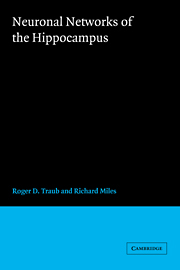Book contents
- Frontmatter
- Contents
- Acknowledgments
- Prologue
- 1 The hippocampus in context
- 2 Physiology of single neurons: voltage- and ligand-gated ionic channels
- 3 Synaptic function and organization of the CA3 region
- 4 The single-cell model
- 5 Model of the CA3 network
- 6 Collective behaviors of the CA3 network: experiment and model
- 7 Collective behaviors of the CA3 network: spontaneous oscillations and synchronized synaptic potentials
- 8 Field effects
- 9 Theoretical approaches: mathematical neural networks
- Conclusion
- Notes
- References
- Index
6 - Collective behaviors of the CA3 network: experiment and model
Published online by Cambridge University Press: 05 February 2012
- Frontmatter
- Contents
- Acknowledgments
- Prologue
- 1 The hippocampus in context
- 2 Physiology of single neurons: voltage- and ligand-gated ionic channels
- 3 Synaptic function and organization of the CA3 region
- 4 The single-cell model
- 5 Model of the CA3 network
- 6 Collective behaviors of the CA3 network: experiment and model
- 7 Collective behaviors of the CA3 network: spontaneous oscillations and synchronized synaptic potentials
- 8 Field effects
- 9 Theoretical approaches: mathematical neural networks
- Conclusion
- Notes
- References
- Index
Summary
In this chapter and the next we shall analyze the interactions that take place between CA3 neurons in a large population (thousands of cells). The cardinal issues are these: Under what conditions does population firing become synchronized? What factors regulate the extent of synchronization? At one extreme, all cells might fire nearly simultaneously (complete synchrony), or alternatively small subsets of neurons might discharge at the same time (partial synchrony). How can one cell, or a small group of cells, influence the rest of the population? If synchronization is partial, rather than complete, what factors determine which selected cells participate?
It is well to consider why we so emphasize synchronization. After all, in principle, the firing pattern in any particular cell might resemble a Poisson process, and the correlation between firing patterns in different cells either might be weak or might assume some particularly complicated form. In that case, we would focus not on synchronization but on factors that, say, regulate the mean firing throughout the population. However, neuronal firing in the hippocampus in vivo (theta rhythm and sharp waves, described in Chapter 1) and in vitro (epileptiform population bursts and synchronized synaptic potentials, described in Chapter 3 and later in this chapter) tends to aggregate into (more or less) discrete “events” or waves. Thus, synchronization of population activity may represent a basic signaling mechanism.
Information
- Type
- Chapter
- Information
- Neuronal Networks of the Hippocampus , pp. 119 - 156Publisher: Cambridge University PressPrint publication year: 1991
Accessibility standard: Unknown
- 1
- Cited by
